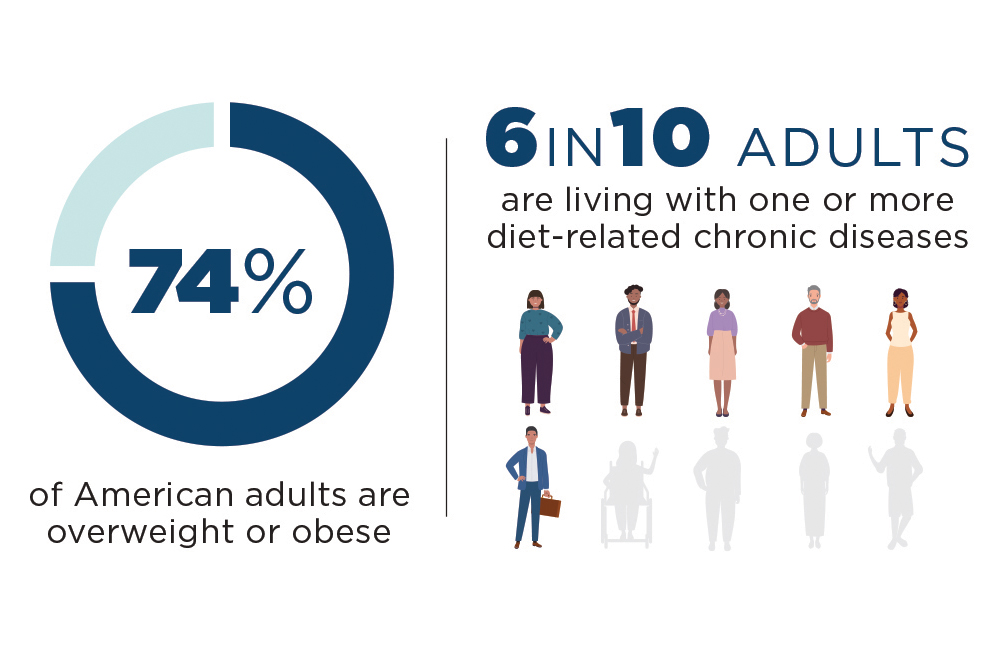
The latest “Dietary Guidelines for Americans” urges the public to commit to a lifelong healthy eating pattern to avoid disease. Source: Dietary Guidelines for Americans, 2020-2025.
This article originally appeared in the February 2021 edition of Senior Scope. Article by Seth Thomas.
A new set of guidelines, published on Dec. 29, urges Americans to focus on nutrient-rich foods, with an emphasis on vegetables, fruits, and whole grains, while limiting sodium, added sugar, saturated fat, and alcohol.
The U.S. Department of Agriculture and the Department of Health and Human Services jointly update the report every five years. The 2020-2025 edition of “Dietary Guidelines for Americans” features more age-specific details than previous iterations.
Even with age-specific recommendations, the document frequently emphasizes “the importance of a healthy dietary pattern as a whole – rather than on individual nutrients or foods in isolation” across the entire lifespan. While recognizing that every stage of life comes with specific dietary needs, the guidelines recognizes the importance of establishing and sticking to a health dietary pattern throughout one’s lifetime to promote health and prevent chronic disease.
According to the guidelines, a healthy dietary pattern includes a relatively higher intake of vegetables, fruits, legumes, whole grains, low- or non-fat dairy, lean meats and poultry, seafood, nuts, and unsaturated vegetable oils. People should consume a relatively lower amount of red and processed meats, sugar-sweetened foods and beverages, and refined grains.
Despite the fact that most Americans do not follow these recommendations, the report notes that people age 60 and above are more likely than any other age group to abide by a healthy eating pattern.
There is room for improvement, however. Below are some recommendations the 2020-2025 Dietary Guidelines offers specifically for people over age 60.
Try a wider variety of proteins: While most older adults are eating adequate amounts of protein, the dietary guidelines suggest adding some variety to your plate. Most older adults source their protein intake from meats, poultry and eggs. The guidelines suggest adding seafood, dairy, beans, peas, lentils and fortified soy alternates, like tofu and tempeh. By adding some of these options to your regular dietary pattern, older adults can better meet their nutritional needs.
Talk to Your Doctor about B12: People over age 60 should consider their intake of vitamin B12, because, for some older adults, the ability to absorb this nutrient can decrease with age. Some medications can decrease absorption as well. Vitamin B12 can be found in a variety of foods, such as fortified breakfast cereals or tuna. Some people may want to consider dietary supplements. Though, the guidelines note that those who are considering a supplement should first talk to their health care provider to determine if that would be appropriate.
Stay Hydrated: On average, older adults drink less fluids than any other age group – about two fewer cups per day, according to the report. Drinking water aids digestion and prevents dehydration. In addition to drinking plenty of water, the guidelines note that the water contained in fruits and vegetables help with fluid intake as does low-fat or fat-free milk.
Limit Alcohol: Put plainly, the guidelines steer the public away from drinking alcohol for any reason. However, the guidelines cap alcohol consumption at two drinks a day for men and one drink a day for women. This decision was met with controversy when the document was initially published, as an advisory panel recommended the cap be one drink a day for both men and women.
Regardless, the final report states that drinking alcohol puts older adults at “higher risk of falls, car crashes, and other injuries that may result from drinking.” Drinking alcohol can also interfere with the management of chronic diseases and can interact with medications.


Recent Comments